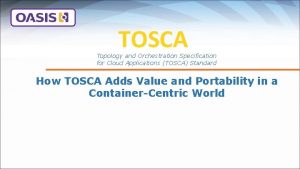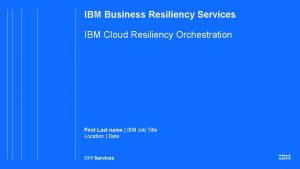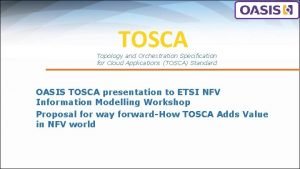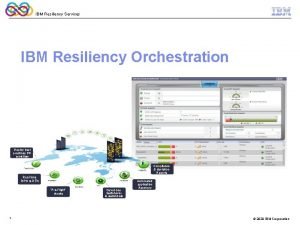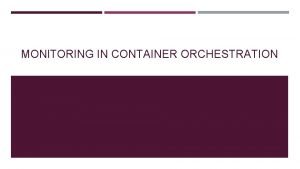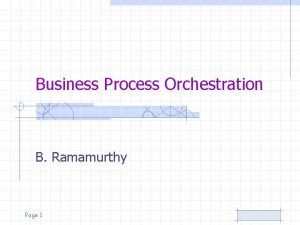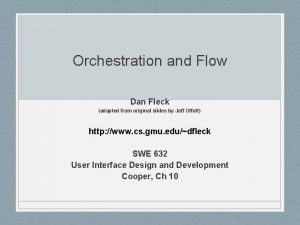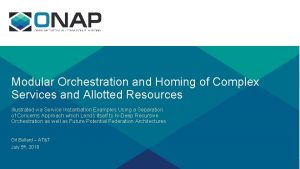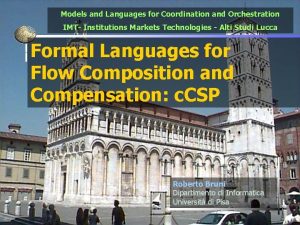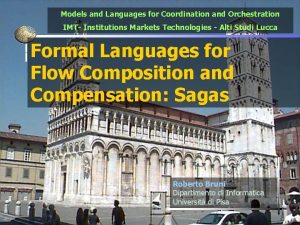Chapter 10 Orchestration and Flow FLOW flow a


















- Slides: 18

Chapter 10: Orchestration and Flow

FLOW flow - a user’s ability to concentrate on an activity In order to create flow, the software must become transparent

Guidelines to Increase Flow follow mental models - user forms a mental image of how the software performs its task - the mind looks for a pattern of cause and effect direct, don’t discuss - the ideal interaction is like using a tool - interaction with the tools should not include a discussion - direct manipulation is an extension of this idea

Guidelines to Increase Flow keep tools close at hand - palettes and toolbars make tools very visible - should be accessible with a single click - info about the current tool should be clearly posted without stopping the action modeless feedback - avoid interruptions for normal feedback

Guidelines to Increase Flow harmonious organization / finesse / invisibility - a user interface is an artifact, not directly related to the user’s goals - all elements of the interface should work toward a single goal - avoid flashy gizmos - there are no fixed rules - less is more - group related tasks together

Guidelines to Increase Flow possibility versus probability - use the probable choice as a default - actual analysis of user interaction provides the best model quantitative information - give actual numeric values in context - accompany by a graphical representation graphical input - use direct manipulation - label with actual measurements

Guidelines to Increase Flow status of program - iconic indicators of what is going on provide templates - something that has a statistically good chance of being correct - provide user with tools for changing it sensible interaction - widgets should behave as their appearances suggest

FLOW flow - a user’s ability to concentrate on an activity In order to create flow, the software must become transparent http: //www. youtube. com/watch? v=QKh 1 Rv 0 Pl. OQ

Chapter 11: Eliminating Excise

Eliminating Excise - unnecessary cognitive and physical effort - extra work that doesn’t go directly towards accomplishment of our goals - work that satisfies needs of the tool GUI excise - extra effort to manipulate windows and menus Command line excise - extra effort to memorize commands

Eliminating Excise Experts - GUI excise should not be eliminated to accommodate power users Facilities for new users - must be easily disabled Hardware Management - should be handled by intelligent behind the scenes software Visual Excise (TMI) - too many visual metaphors, highly stylized text, difficult to identify navigational elements

Eliminating Excise Interruption of flow - only when unavoidable Error messages and confirmations - often must acknowledge something incomprehensible Modifiable options - should be accessible without additional dialogs

Eliminating Excise Navigational excise - place all main interactions in a single primary view (avoid unnecessary separate windows) - tabbed panes as an alternative to adjacent panes - commonly used tools should be available simultaneously - reduce the number of places to go - make persistent objects to facilitate navigation - provide useful overviews (textual or graphical, breadcrumb, annotated scroll bar)

Eliminating Excise Use intuitive mapping of controls to functions Make commonly used functions available at all times Avoid hierarchies Example: the positioning of burner controls on stoves

Chapter 12: Designing Good Behavior

Designing Good Behavior Designing Considerate Products • Memory of habits and preferences • Polite, not judgmental, makes suggestions • Common sense error handling • Anticipation of needs, use of idle cycles • Conscientious, handling of filename reuse properly • Quiet about successes and intelligence in handling failures

Designing Good Behavior Designing Considerate Products • Use modeless feedback to keep user informed • Perceptive about possible interests • Avoiding need for confirmation • Avoiding unnecessary questions • Failing gracefully • Ability to “bend the rules” • Ability to take responsibility for a user request

Designing Good Behavior Designing Smart Products • Using the idle cycles • Memory about how the product was used previously (choices, defaults, usage patterns) • Memory about files and file locations • Multi-session undo
 Database applications
Database applications Orchestration designer
Orchestration designer Multi domain service orchestration
Multi domain service orchestration Business resiliency services
Business resiliency services Bbs
Bbs Tosca topology
Tosca topology Orchestration is about codifying tasks
Orchestration is about codifying tasks Hp cloud service automation
Hp cloud service automation Ibm resiliency orchestration sanovi
Ibm resiliency orchestration sanovi Forrester wave real time interaction management
Forrester wave real time interaction management Biztalk bam tutorial
Biztalk bam tutorial Conversation orchestration
Conversation orchestration Container orchestration monitoring
Container orchestration monitoring Business process orchestration
Business process orchestration Tosca demo
Tosca demo Tosca cloud orchestration
Tosca cloud orchestration Tosca orchestration
Tosca orchestration Enfv
Enfv Hp operation orchestration
Hp operation orchestration
